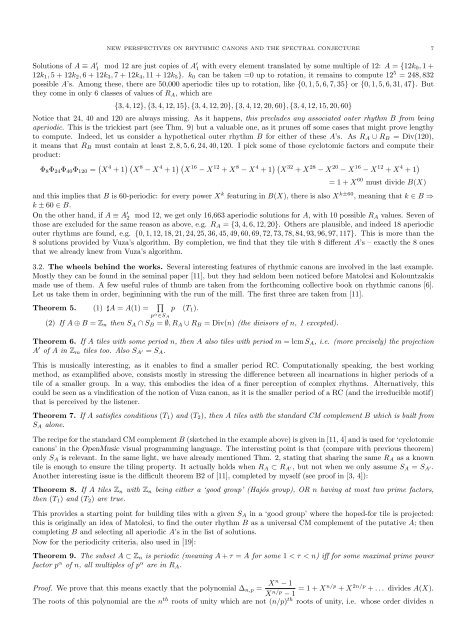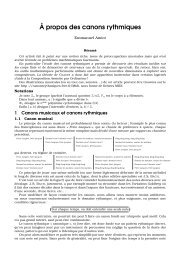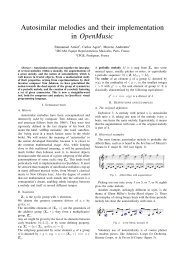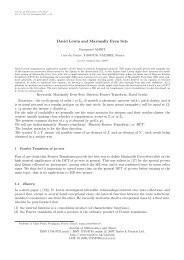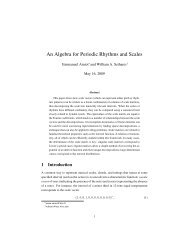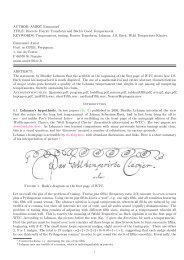Emmanuel Amiot Modèles algébriques et algorithmes pour la ...
Emmanuel Amiot Modèles algébriques et algorithmes pour la ...
Emmanuel Amiot Modèles algébriques et algorithmes pour la ...
Create successful ePaper yourself
Turn your PDF publications into a flip-book with our unique Google optimized e-Paper software.
NEW PERSPECTIVES ON RHYTHMIC CANONS AND THE SPECTRAL CONJECTURE 7<br />
Solutions of A ≡ A ′ 1 mod 12 are just copies of A ′ 1 with every element trans<strong>la</strong>ted by some multiple of 12: A = {12k0, 1 +<br />
12k1, 5 + 12k2, 6 + 12k3, 7 + 12k4, 11 + 12k5}. k0 can be taken =0 up to rotation, it remains to compute 12 5 = 248, 832<br />
possible A’s. Among these, there are 50,000 aperiodic tiles up to rotation, like {0, 1, 5, 6, 7, 35} or {0, 1, 5, 6, 31, 47}. But<br />
they come in only 6 c<strong>la</strong>sses of values of RA, which are<br />
{3, 4, 12}, {3, 4, 12, 15}, {3, 4, 12, 20}, {3, 4, 12, 20, 60}, {3, 4, 12, 15, 20, 60}<br />
Notice that 24, 40 and 120 are always missing. As it happens, this precludes any associated outer rhythm B from being<br />
aperiodic. This is the trickiest part (see Thm. 9) but a valuable one, as it prunes off some cases that might prove lengthy<br />
to compute. Indeed, l<strong>et</strong> us consider a hypoth<strong>et</strong>ical outer rhythm B for either of these A’s. As RA ∪ RB = Div(120),<br />
it means that RB must contain at least 2, 8, 5, 6, 24, 40, 120. I pick some of those cyclotomic factors and compute their<br />
product:<br />
Φ8Φ24Φ40Φ120 = X 4 + 1 X 8 − X 4 + 1 X 16 − X 12 + X 8 − X 4 + 1 X 32 + X 28 − X 20 − X 16 − X 12 + X 4 + 1 <br />
= 1 + X 60 must divide B(X)<br />
and this implies that B is 60-periodic: for every power X k featuring in B(X), there is also X k±60 , meaning that k ∈ B ⇒<br />
k ± 60 ∈ B.<br />
On the other hand, if A ≡ A ′ 2 mod 12, we g<strong>et</strong> only 16,663 aperiodic solutions for A, with 10 possible RA values. Seven of<br />
those are excluded for the same reason as above, e.g. RA = {3, 4, 6, 12, 20}. Others are p<strong>la</strong>usible, and indeed 18 aperiodic<br />
outer rhythms are found, e.g. {0, 1, 12, 18, 21, 24, 25, 36, 45, 49, 60, 69, 72, 73, 78, 84, 93, 96, 97, 117}. This is more than the<br />
8 solutions provided by Vuza’s algorithm. By compl<strong>et</strong>ion, we find that they tile with 8 different A’s – exactly the 8 ones<br />
that we already knew from Vuza’s algorithm.<br />
3.2. The wheels behind the works. Several interesting features of rhythmic canons are involved in the <strong>la</strong>st example.<br />
Mostly they can be found in the seminal paper [11], but they had seldom been noticed before Matolcsi and Kolountzakis<br />
made use of them. A few useful rules of thumb are taken from the forthcoming collective book on rhythmic canons [6].<br />
L<strong>et</strong> us take them in order, begininning with the run of the mill. The first three are taken from [11].<br />
Theorem 5. (1) ♯A = A(1) = <br />
p (T1).<br />
p α ∈SA<br />
(2) If A ⊕ B = Zn then SA ∩ SB = ∅, RA ∪ RB = Div(n) (the divisors of n, 1 excepted).<br />
Theorem 6. If A tiles with some period n, then A also tiles with period m = lcm SA, i.e. (more precisely) the projection<br />
A ′ of A in Zm tiles too. Also SA ′ = SA.<br />
This is musically interesting, as it enables to find a smaller period RC. Computationally speaking, the best working<br />
m<strong>et</strong>hod, as examplified above, consists mostly in stressing the difference b<strong>et</strong>ween all incarnations in higher periods of a<br />
tile of a smaller group. In a way, this embodies the idea of a finer perception of complex rhythms. Alternatively, this<br />
could be seen as a vindification of the notion of Vuza canon, as it is the smaller period of a RC (and the irreducible motif)<br />
that is perceived by the listener.<br />
Theorem 7. If A satisfies conditions (T1) and (T2), then A tiles with the standard CM complement B which is built from<br />
SA alone.<br />
The recipe for the standard CM complement B (sk<strong>et</strong>ched in the example above) is given in [11, 4] and is used for ‘cyclotomic<br />
canons’ in the OpenMusic visual programming <strong>la</strong>nguage. The interesting point is that (compare with previous theorem)<br />
only SA is relevant. In the same light, we have already mentioned Thm. 2, stating that sharing the same RA as a known<br />
tile is enough to ensure the tiling property. It actually holds when RA ⊂ RA ′, but not when we only assume SA = SA ′.<br />
Another interesting issue is the difficult theorem B2 of [11], compl<strong>et</strong>ed by myself (see proof in [3, 4]):<br />
Theorem 8. If A tiles Zn with Zn being either a ‘good group’ (Hajós group), OR n having at most two prime factors,<br />
then (T1) and (T2) are true.<br />
This provides a starting point for building tiles with a given SA in a ‘good group’ where the hoped-for tile is projected:<br />
this is originally an idea of Matolcsi, to find the outer rhythm B as a universal CM complement of the putative A; then<br />
compl<strong>et</strong>ing B and selecting all aperiodic A’s in the list of solutions.<br />
Now for the periodicity criteria, also used in [19]:<br />
Theorem 9. The subs<strong>et</strong> A ⊂ Zn is periodic (meaning A + τ = A for some 1 < τ < n) iff for some maximal prime power<br />
factor p α of n, all multiples of p α are in RA.<br />
Proof. We prove that this means exactly that the polynomial ∆n,p = Xn − 1<br />
X n/p − 1 = 1 + Xn/p + X 2n/p + . . . divides A(X).<br />
The roots of this polynomial are the n th roots of unity which are not (n/p) th roots of unity, i.e. whose order divides n


